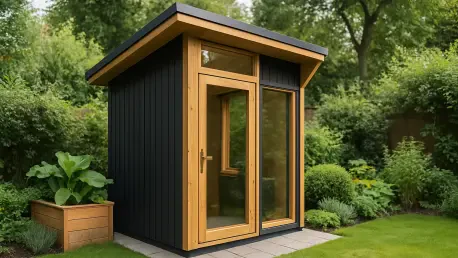What happens when a narrow, overlooked corner of a garden transforms into a beacon of innovation, and how does it challenge conventional ideas about outdoor spaces? In Plumstead, South-East London, a small outdoor area has become the stage for a groundbreaking design that redefines everything known about garden sheds. Engineer Mike Robinson has crafted a structure so ingenious that it captured the coveted Cuprinol Shed of the Year title in the workshop/studio category. This tiny marvel isn’t just a shed—it’s a bold statement on maximizing space and creativity in an era where every square foot counts.
The Rising Need for Smart Outdoor Spaces
The importance of reimagining small spaces has never been clearer. With urban areas growing denser and home-based work becoming the norm, studies indicate that over 60% of homeowners now seek multifunctional outdoor areas for personal projects or storage, according to recent housing trend reports. Robinson’s creation, known as ‘The Tiny Workshop,’ addresses this pressing demand head-on. It stands as a symbol of how necessity drives innovation, proving that even the smallest footprint can yield extraordinary results in today’s space-starved environments.
This story isn’t just about a shed; it’s about rethinking boundaries. As more individuals look to adapt their properties for dual purposes—whether for hobbies, remote work, or simply decluttering—the impact of such designs extends far beyond personal convenience. It reflects a broader movement toward sustainable living and resourceful use of limited areas, setting a precedent for what garden structures can achieve in modern times.
Unveiling the Magic of a Compact Masterpiece
At first glance, ‘The Tiny Workshop’ appears as a modest shed painted in sleek Black Ash by Cuprinol, blending seamlessly into its garden backdrop. But the true genius emerges when its innovative door flaps are opened. One flap extends to form an additional floor, while the other becomes a protective roof against rain, effectively doubling the usable space in seconds. This expandable feature turns a cramped area into a functional workspace without compromising the garden’s aesthetic.
Inside, meticulous organization defines the layout. A compact desk setup maximizes every inch, with tools neatly arranged for efficiency. Folding panels serve a dual purpose as equipment hangers, ensuring quick access while keeping the floor clear. Additionally, an overhanging green roof not only integrates the shed with its natural surroundings but also provides extra storage for garden essentials, merging beauty with practicality in a striking way.
Personal touches elevate the design further. Unique door handles, crafted from repurposed wrenches with 3D-printed brackets, nod to the workshop’s purpose while showcasing Robinson’s knack for creative reuse. These details transform the shed into more than storage—it’s a space for tinkering, repairs, and even children’s games, redefining versatility in outdoor structures.
The Mind Behind the Innovation
Necessity sparked Robinson’s vision for this extraordinary project. Faced with a narrow garden space that couldn’t accommodate standard storage solutions, he took matters into his own hands, designing a custom DIY shed that balances function with form. “The goal was to create a place for work and storage without losing the garden’s charm,” Robinson explains, emphasizing his commitment to preserving the outdoor environment while meeting practical needs.
His efforts didn’t go unnoticed. Andrew Wilcox, founder and head judge of Cuprinol Shed of the Year, lauded the design for its ingenuity. “This shed achieves remarkable functionality in such a limited footprint,” Wilcox notes. “It elevates the concept from basic storage to a truly inspired space.” His words highlight how Robinson’s work resonates with a growing need for compact, efficient solutions in an era of shrinking personal spaces.
The recognition from industry experts underscores the design’s broader impact. It’s not merely a personal triumph but a benchmark for others facing similar spatial challenges. The fusion of practicality and creativity in this shed offers a glimpse into how individual problem-solving can inspire collective change in home design trends.
Lessons from a Small Space Revolution
This award-winning shed provides actionable insights for anyone looking to transform their own outdoor areas. Start by thinking beyond traditional limits—consider expandable elements like foldable panels or multi-purpose surfaces to stretch tight spaces. Sketching out dual roles for a shed, such as combining a workspace with storage, can reveal untapped potential in even the smallest corner.
Organization remains key to success. Dedicate time to custom layouts, utilizing walls or doors for hanging tools to keep the area uncluttered. Affordable solutions like pegboards or modular shelves can turn chaos into order, ensuring every tool has its place. Such strategies maximize usability without requiring extensive renovations or costly investments.
Eco-friendly and personal touches can also make a difference. Integrating a green roof or plant shelves harmonizes a shed with its surroundings while adding utility like shade or storage. Similarly, repurposing old materials—think scrap wood or outdated hardware—can craft unique features that reflect individual style, making the space both functional and meaningful.
Reflecting on a Groundbreaking Achievement
Looking back, ‘The Tiny Workshop’ by Mike Robinson stood as a powerful example of ingenuity overcoming constraint. Its clever design and multifunctional approach earned well-deserved acclaim, proving that limited space was no barrier to brilliance. The shed’s recognition in a prestigious competition highlighted its role as a pioneer in rethinking outdoor structures.
Moving forward, the inspiration drawn from this project encouraged countless others to reimagine their own small spaces. Homeowners could start by assessing their needs and experimenting with modular or expandable designs to suit their lifestyles. Exploring sustainable elements or personal customizations offered a path to create not just sheds, but unique extensions of living spaces.
The legacy of this design prompted a shift in perspective—challenging the notion that bigger was always better. By focusing on smart, resourceful solutions, anyone could transform overlooked areas into hubs of productivity and creativity. This small shed left a lasting mark, inviting all to think creatively about the potential lying dormant in their own backyards.









